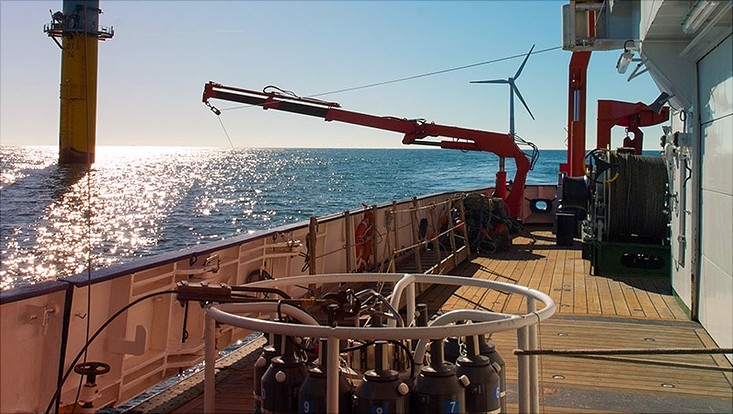Like small blenders in the sea: offshore wind turbines
17 August 2017, by Franziska Neigenfind

Photo: UHH/CEN/Floeter
Along Germany’s coast they seem to sprout up like mushrooms: offshore wind farms. Dozens of wind turbines, each over 100 meters tall, produce renewable electricity for our households. But do these farms disturb marine ecosystems? Or do they actually have a positive effect?
To answer these questions, we are currently investigating two wind farms off the north coast of Eastern Friesland. Once a year we travel through the offshore wind farms on the research ship Heincke. During these two-week expeditions, we always have the Triaxus sensor system in tow. Equipped with various measurement instruments, it moves independently, bobbing up and down between the surface and the sea floor, measuring – among other things – the water temperature and the concentration of phytoplankton, which are minute algae.
The two wind farms cover an area greater than 10,000 soccer fields and their turbines provide enough electricity to supply over 800,000 households. Together with colleagues from Universität Hamburg’s Center for Earth Systems Research and Sustainability, the Helmholtz-Zentrum Geesthacht and the University of Oldenburg, we were able to collect the first data even before the wind farms were installed – since even the turbines’ bases could affect the water flow.
Our data confirms that assumption: on the leeward side of the turbine bases we have observed turbulence similar to that behind bridge piers in a river. The bases act like small mixers in the sea – the turbulence increases the mixing of the water and the usual “layering” effect is weakened. Normally, in summer there is a layer of warm water at the top and a separate, colder layer below. Anyone who’s ever swum in a lake knows this phenomenon: our feet are sometimes in much colder water than our torsos.
Usually there is little exchange between these two layers, and since the microalgae have already consumed most of the nutrients in the upper layer by spring, they usually only multiply slowly in summer. However, the turbulence is now transporting nutrients from the deeper water to the topmost layer, allowing the algae to multiply faster. During the expedition, we discovered veritable “plankton columns” – water masses several hundred meters in diameter with particularly high algae concentrations. Our next task is to find out exactly how these columns are formed, and what effect they have.
It’s possible, for example, that zooplankton benefit from the increased algae concentrations, since these microscopic crustaceans feed on phytoplankton microalgae. If they do, then the waters between the turbines should offer rich pickings for the fish that feed on zooplankton. This in turn would mean that larger fish – such as cod – that feed on other fish would also benefit from the increase in potential prey. The farms could become a refuge for various fish species, producing a positive effect on the ecosystem. In addition, the rotors’ slowing effect on the wind could change the layering of the water in the summer, affecting an area far larger than the wind farms themselves. To get to the bottom of these effects, we’ll soon be heading back out to sea: the next voyage is planned for September.
This content was first published as a guest article in the newspaper Hamburger Abendblatt on 14th August 2017
Dr. Jens Floeter is a biologist and fisheries science expert.
